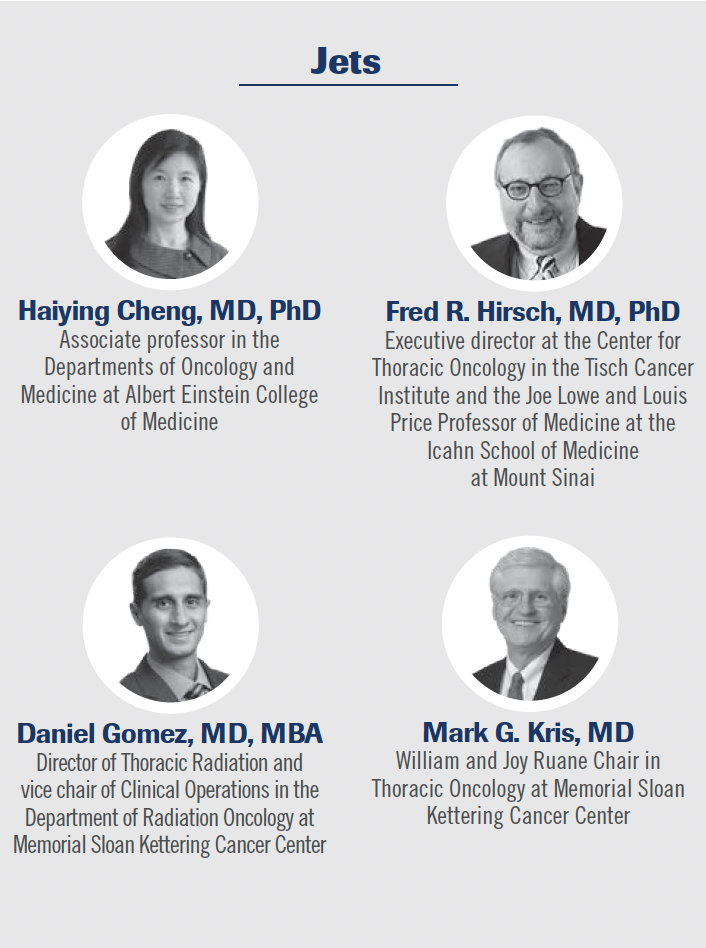Clinicians Face Off Regarding New Trials in NSCLC Space
The CROWN and ADURA trials were discussed and defended as part of a non–small cell lung cancer Face Off.
Jets

Giants

In a recent Face-Off program hosted by CancerNetwork, experts went
head-to-head to discuss recent data on non–small cell lung cancer (NSCLC). The panelists were split into 2 teams, the Jets and the Giants, and presented data regarding recent advancements and pivotal trial results in the field.
CROWN Trial
The phase 3 CROWN trial (NCT03052608) focused on patients with previously untreated ALK-positive NSCLC.1 Patients were randomly assigned 1:1 to receive 100 mg of oral lorlatinib (Lorbrena) once a day or 250 mg of oral crizotinib (Xalkori) twice a day. Patients were stratified by the presence of brain metastases and by ethnicity.
The primary end point of the trial was progression-free survival (PFS) by blinded independent central review and cumulative incidence of central nervous system (CNS) progression. Secondary end points included overall survival, PFS by investigator assessment, and objective response rate.
The median PFS for those with brain metastases was not reached (NR) in the lorlatinib arm vs 7.2 months in the crizotinib arm. The 12-month PFS rates were 78% (95% CI, 60%-88%) and 22% (95% CI, 9%-39%; HR, 0.20, 95% CI, 0.10-0.43; P < .0001) in the lorlatinib and crizotinib arms, respectively. In patients without brain metastases, the median PFS was NR vs 11.0 months. The 12-month PFS rates were 78% (95% CI, 69%-85%) and 45% (95% CI, 34%-55%; HR, 0.32, 95% CI, 0.20-0.49; P < .0001) in each respective arm.
In terms of the incidence of CNS progression, 12-month rates were 7% with lorlatinib and 72% with crizotinib in patients with baseline brain metastases (HR, 0.07; 95% CI, 0.02-0.24) and 1% with lorlatinib and 18% with crizotinib in patients without baseline brain metastases (HR, 0.05; 95% CI, 0.01-0.42).
Adverse effects (AEs) related to CNS progression were seen in 35% of patients who received lorlatinib and 11% of patients who received crizotinib. A total of 62% of patients in the lorlatinib arm and 73% of patients in the crizotinib arm experienced grade 1 AEs, 29% in the lorlatinib arm and 27% in the crizotinib arm had grade 2 AEs, and 10% in the lorlatinib arm had grade 3 AEs. These included cognitive effects, mood effects, speech effects, and psychotic effects.
Use of Lorlatinib in First- vs Second-Line Setting
Chaft: There have been a number of previous trials in this space, and the control arm [in the CROWN trial] is wrong. [How does this compare with] what is [the current] standard frontline therapy?
Cheng: We consider the efficacy, toxicity, and patient preference. The financial [ability] should be similar in terms of those frontline ALK inhibitors. I have used alectinib (Alecensa) and have the most experience with it. I also used relatlimab (Opdualag) and brigatinib (Alunbrig) for some of my patients, so the cognitive abnormality is real. I had to do a dose reduction for 2 of my patients. Numerically, [lorlatinib] does have more efficacy even when we don’t have a head-to-head comparison.
Kris: That’s the problem. My personal experience with lorlatinib in the second-line setting is that there are significant comorbidities associated with it. Especially with the patients [who have ALK-positive disease] and can expect very long-term duration on the frontline treatment, would you want to use something that will negatively impact their quality of life? Alectinib is much better tolerated. Brigatinib perhaps is better than lorlatinib, but I struggle with keeping patients on lorlatinib for a long time.
Chaft: The weight gain, the metabolic abnormalities, and the psychological disturbance are a big deal. It’s also potentially effective in the second line.
Cheng: We have to give a patient the best treatment in the beginning.
Doroshow: Is there any evidence that starting patients with alectinib or brigatinib and then switching to lorlatinib if you need better CNS control is any worse than starting them off with lorlatinib and affecting their quality of life?
Kris: I’d like to challenge [the idea that lorlatinib affects] quality of life. All you have to do is lower the dose and everything is just fine. You get the same expected response and PFS using a lower dose.
I was very impressed by that recent article in the Journal of Thoracic
Oncology about alectinib and weight gain.2 Everyone has blown it off, but it’s there. The edema is there, so all these drugs have those AEs.
Doroshow: If you have cognitive impairment or depression, it’s great if it resolves with dose reduction, but it still happened. It was still probably awful for patients and their families.
Kris: Progression of the disease is a lot worse.
Velcheti: We don’t know whether using lorlatinib in the front line is better than alectinib. You can still use it in the postprogression setting, not every time, but when patients progress on alectinib, depending on the kind of mechanisms, you can certainly use it in the second line.
Kris: My mentor always said to give the best treatment first.
Hirsch: At the end of the day, what the patient is looking for is the overall survival; what treatment sequence or treatment [will give the patient] the best chance to live? We don’t know, in all honesty, what the best sequence is in terms of long-term survival. That is a valid point. Another thing: I hope we soon [understand the relationships between mutations and] ALK inhibitors. We will be learning more and more about specific mutations that can be sensitive to one drug and resistant to another drug. Hopefully, that will give us better guidance in the future.
ADURA Trial
The phase 3 ADAURA trial (NCT02511106) included 682 patients with stage IB to IIIA EGFR-mutated NSCLC.3 Patients were randomly assigned 1:1 to receive 80 mg of osimertinib (Tagrisso) daily or placebo for
3 years. Patients were stratified by disease stage, status of mutation, and race.
The primary end point of the study was disease-free survival (DFS) by investigator assessment in stage II to IIIA disease. Secondary end points included DFS in stage IB to IIIA, overall survival, and safety.
For patients with stage II to IIIA disease, the median follow-up was
44.2 months (range, 0-67 months) for the osimertinib arm and 19.6 months
(range, 0-70 months) for the placebo arm. The 4-year DFS rate was 70% for the osimertinib arm and 29% for the placebo arm. Median DFS in the osimertinib arm was 65.8 months (95% CI, 54.4-not calculable [NC]) and 21.9 months (95% CI, 16.6-27.5) in the placebo arm. At 48 months, 70% (95% CI, 62%-76%) of patients in the osimertinib arm and 29% (95% CI, 23%-35%) of patients in the placebo arm were disease free.
In the overall population with stage IB to IIIA disease, the median DFS was 65.8 months (95% CI, 61.7-NC) for the osimertinib arm compared with 28.1 months (95% CI, 22.1-35.0) for the placebo arm. At 48 months, 73% (95% CI, 67%-78%) of all patients in the osimertinib arm and 38% (95% CI, 32%-43%) of patients in the placebo arm were disease free.
AEs were reported in 98% of patients in the osimertinib arm and 90% of patients in the placebo arm. The most common AEs in the experimental and control arms, respectively, were diarrhea (47% vs 20%), paronychia (27% vs 1%), and dry skin (25% vs 7%). A total of 23% of patients in the experimental arm and 14% in the control arm experienced AEs of grade 3 or higher. One AE in the experimental arm and 2 in the control arm resulted in death.
Osimertinib vs Standard-of-Care Chemotherapy
Hirsch: The data are very convincing and encouraging. I’m biomarker focused. If you are looking into the hazard ratios and the first plot, there is a difference between the submutations. I don’t think it is a statistical difference, but there was a difference.
Chaft: This is expected. Every EGFR study ever done [shows this].
Hirsch: I certainly know that. Does it affect a choice of treatment? No, but an interesting observation it is.
Chaft: What are your thoughts on postoperative radiation?
Gomez: Post-op radiation is controversial now. I don’t think that’s a real limitation. Despite the team affiliation, I think the results are relatively
[characteristic for this drug].
Chaft: Last week, a man came to my clinic who completed his 3 years of adjuvant osimertinib, now a year and a half ago, with relapse. The biggest question remains about the duration
of therapy.
Gomez: Isn’t there an ongoing study looking at longer duration of therapy?
Chaft: Not in the United States. There is one in China.
Chudgar: [The patient population in this trial was patients with] stage IB disease, and the HR is 0.4. Should we be referring everybody, even patients with resected stage IA disease?
Kris: One of the big issues now is, what about chemotherapy? Does this mean you don’t need chemotherapy?
Chaft: These drugs haven’t been proven to cure patients yet, whereas chemotherapy has been, so we should be giving both. That’s the fatal flaw of the phase 3 ALINA study [NCT03456076].3
Kris: People are going to be using that. The ALINA study included patients with ALK-mutant resected lung cancers. [The study compared chemotherapy and alectinib], and alectinib was better.
[Clinicians] are taking that to say you should just give patients alectinib.
Chaft: All the data in ALK-positive disease shows a very minimal response rate for chemotherapy, but it’s the standard of care.
The winner in the Jets vs Giants Face-Off was determined to be the Giants!
References
- Solomon BJ, Bauer TM, Ignatius Ou SH, et al. Post hoc analysis of lorlatinib intracranial efficacy and safety in patients with ALK-positive advanced non–small-cell lung cancer from the phase III CROWN study. J Clin Oncol. 2022;40(31):3593-3602. doi:10.1200/jco.21.02278
- de Leeuw SP, Pruis MA, Sikkema BJ, et al. Analysis of serious weight gain in patients using alectinib for ALK-positive lung cancer. J Thorac Oncol. 2023;18(8):1017-1030. doi:10.1016/j.jtho.2023.03.020
- Herbst RS, Wu YL, John T, et al. Adjuvant osimertinib for resected EGFR-mutated stage IB-IIIA non–small-cell lung cancer: updated results from the phase III randomized ADAURA trial. J Clin Oncol. 2023;41(10):1830-1840. doi:10.1200/jco.22.02186